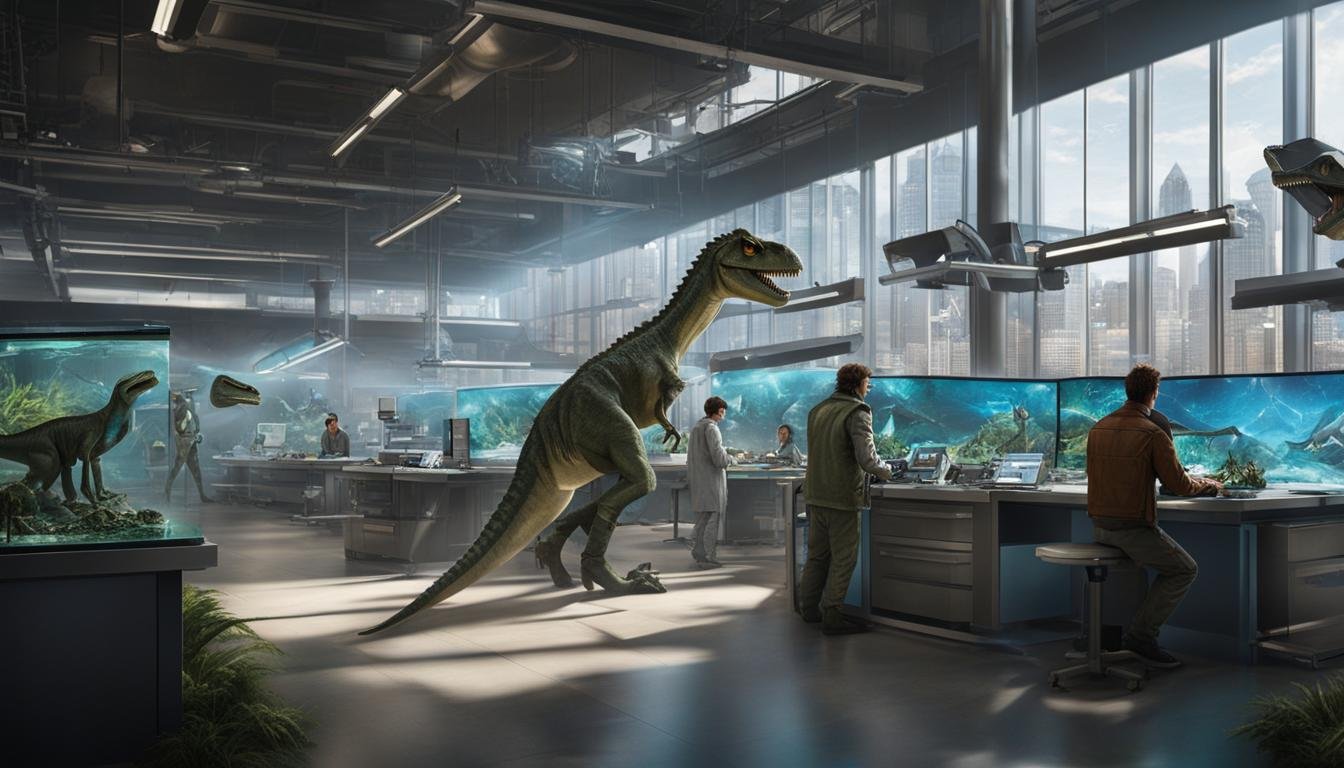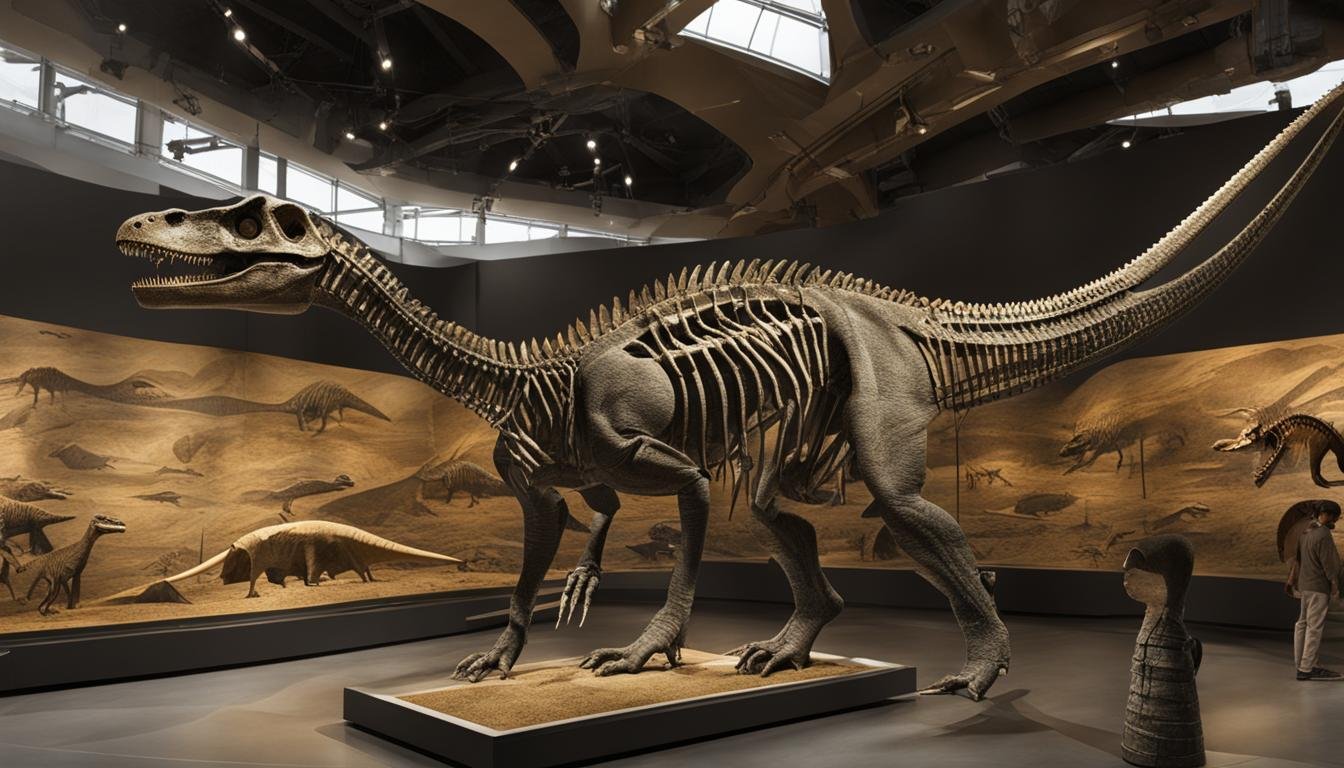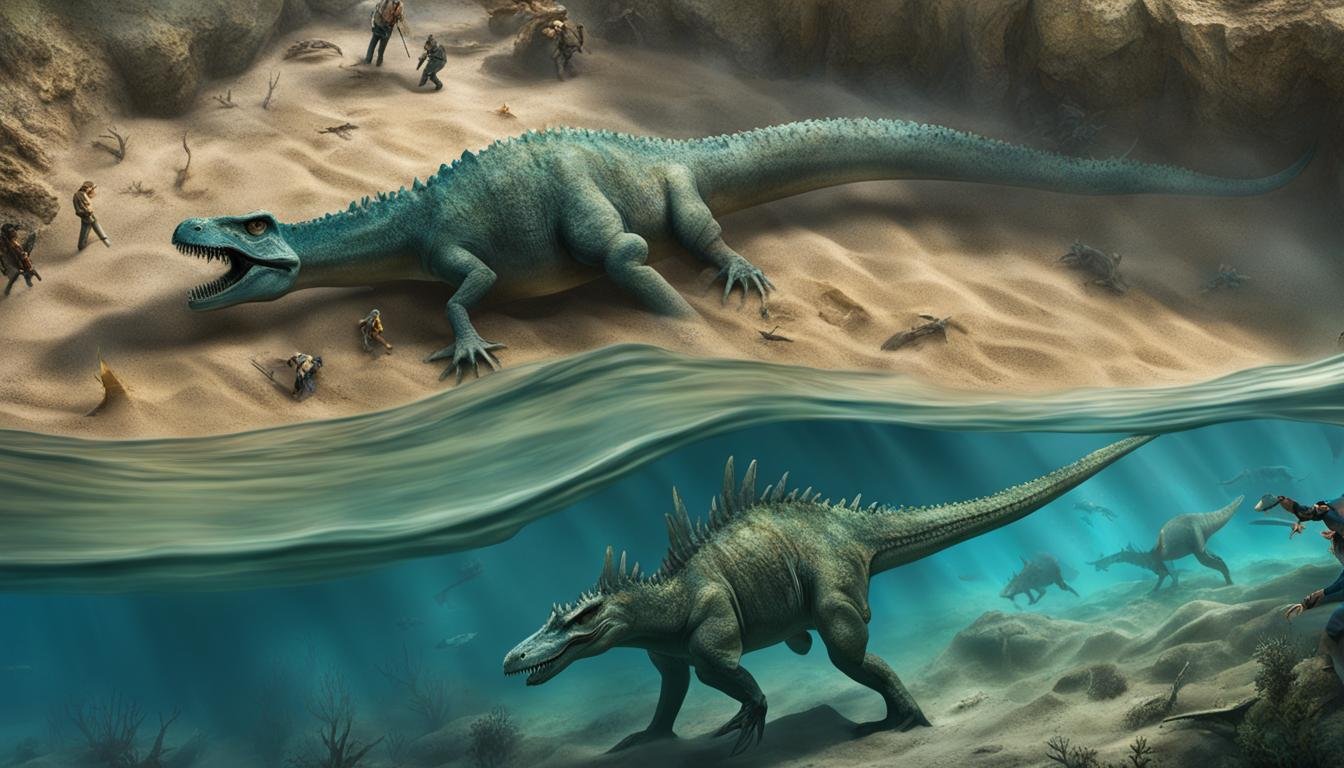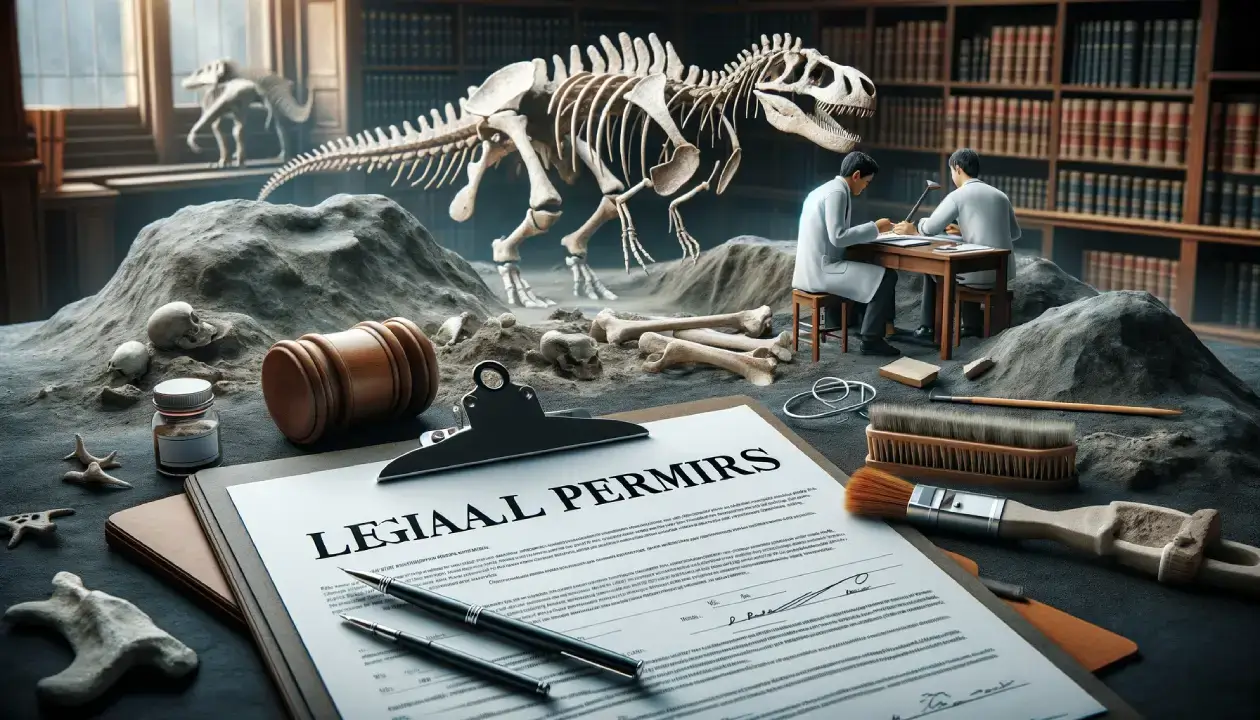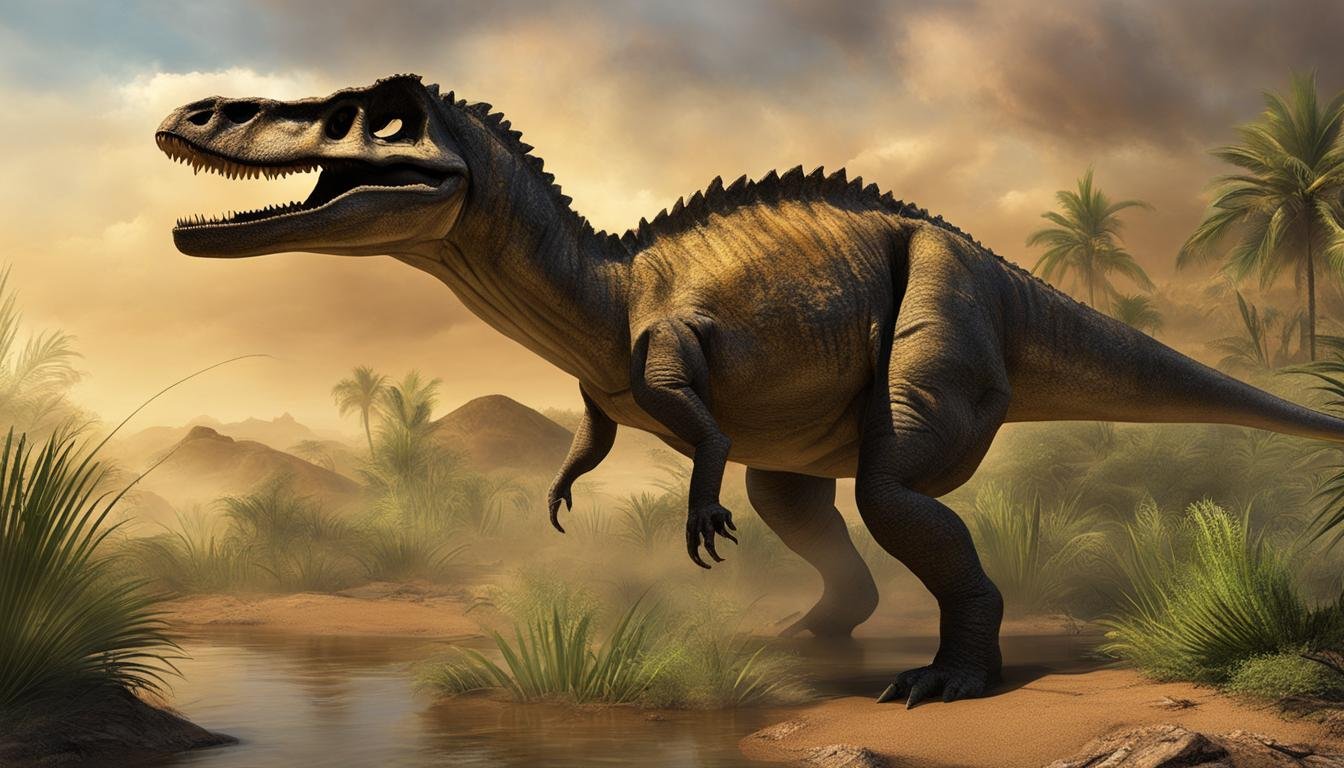The field of dinosaur paleontology is constantly evolving, driven by new discoveries, groundbreaking research, and the latest developments in studying these magnificent creatures. With each fossil finding, paleontologists uncover more about the long history of life on Earth, shedding light on the evolution of dinosaurs and their ecosystems.
While the study of fossils provides direct evidence of ancient life forms, it also plays a crucial role in understanding present-day environmental challenges, such as climate change and ocean acidification. Despite the declining support and resources, paleontology remains at the forefront of modern science, utilizing a range of multidisciplinary tools and techniques to unlock the secrets of our planet’s past.
| Key Points | Takeaways |
|---|---|
| Continual Discovery | Paleontology continually uncovers new information about dinosaurs, enhancing our understanding of Earth’s history. |
| Advancements in Paleoecology | Modern techniques provide deeper insights into dinosaur behaviors and interactions. |
| Technology’s Impact | Technological innovations significantly advance paleontological research. |
| Multidisciplinary Approaches | Combining various scientific disciplines enriches our understanding of dinosaurs. |
| Evolutionary Insights | New discoveries are reshaping our perception of dinosaur evolution and diversity. |
| Potential for Future Discoveries | Vast unexplored territories hold the promise of uncovering more dinosaur species. |
| Importance of Support | Continued funding and resources are crucial for sustaining and advancing paleontological research. |
Key Takeaways:
- The field of dinosaur paleontology continues to produce new and exciting discoveries.
- Advancements in dinosaur paleoecology allow researchers to study the behaviors and interactions of dinosaurs.
- Technological innovations have greatly enhanced paleontological research, enabling scientists to uncover hidden details in fossils.
- The evolving field of dinosaur paleontology combines knowledge from various disciplines to gain a holistic understanding of these ancient creatures.
- New discoveries are reshaping our understanding of dinosaur evolution and adding to the diversity of known species.
Advancements in Dinosaur Paleoecology
Paleontologists are at the forefront of groundbreaking research in dinosaur paleoecology, utilizing emerging techniques and technologies to delve deeper into the study of ancient creatures. With the use of advanced tools and methods, scientists can now analyze various aspects of dinosaur behavior, morphology, and paleoenvironments, revealing fascinating insights into their lives.
One area of advancement is the study of dinosaur behavior. By examining footprints, trackways, and bone microstructure, researchers can infer the movement patterns, feeding habits, and social structures of dinosaurs. This information provides a glimpse into their daily lives and interactions within their ecosystems.
The study of dinosaur morphology has also seen significant progress. Through careful examination of fossil bones and teeth, paleontologists can determine the physical characteristics of dinosaurs and understand how they evolved over time. Microscopic analysis of bone tissue allows scientists to study growth patterns, age determination, and even the presence of diseases or injuries in dinosaurs.
Dinosaur Behavior
| Behavior | Description |
|---|---|
| Herding | Dinosaurs exhibited herding behavior, similar to modern-day animals like wildebeest or bison. This behavior provided protection against predators and facilitated mate selection. |
| Migration | Some dinosaur species are now believed to have migrated seasonally in search of food and favorable habitats, similar to the patterns observed in modern bird migrations. |
| Nest-Building | Evidence of nesting sites and parental care suggests that certain dinosaurs engaged in nest-building behavior and cared for their eggs and young. |
The advancements in dinosaur paleoecology have revolutionized our understanding of these ancient creatures. By combining data from various disciplines and employing innovative techniques, paleontologists continue to uncover new discoveries and shed light on the mysteries of dinosaur evolution.
“The study of dinosaur paleoecology provides a window into the ancient world and helps us comprehend the complex ecosystems in which dinosaurs thrived.” – Dr. Mary Johnson, Paleontologist
Technological Innovations in Paleontological Research
Paleontological research has been revolutionized by technological advancements, allowing scientists to uncover new insights into ancient creatures. Cutting-edge methods and tools are being utilized in the study of dinosaur fossils, enabling researchers to delve deeper into the mysteries of the past.
One of the key technological innovations in paleontological research is the use of high-resolution satellite imagery. This has been instrumental in identifying potential fossil sites and guiding excavation efforts. By analyzing images from space, scientists can identify geological formations and areas with a high likelihood of containing fossil remains. This technology has greatly improved the efficiency and accuracy of fieldwork, enabling paleontologists to focus their efforts on the most promising locations.
“The use of high-resolution satellite imagery has revolutionized the field of paleontological research, allowing us to discover and excavate fossil sites more effectively than ever before. It has truly transformed the way we study ancient creatures.” – Dr. Sarah Johnson, Paleontologist.
In laboratories, advanced tools and techniques have also played a crucial role in paleontological research. High-speed saws and precision instruments allow scientists to carefully extract fossils from their surrounding rock matrix. This delicate process ensures the preservation of important anatomical features and provides access to hidden details that may not be visible to the naked eye.
Furthermore, cutting-edge analytical techniques such as laser spectrometry, CT scanning, and synchrotron imaging have provided invaluable insights into the chemical composition, internal structure, and microarchitecture of fossils. By studying these intricate details, paleontologists gain a deeper understanding of ancient creatures, their behavior, and their evolutionary adaptations.
The Future of Paleontological Research
As technology continues to advance, the future of paleontological research holds even greater promise. From the development of more sophisticated imaging techniques to the application of artificial intelligence and machine learning in data analysis, there are endless possibilities for further discoveries and insights.
By embracing these technological advancements and investing in the field of paleontology, we can continue to unlock the secrets of our planet’s ancient past. Through the study of ancient creatures, we not only gain a deeper understanding of our own evolutionary history but also valuable insights into the challenges we face in preserving modern biodiversity and combating climate change.
Technological innovations are providing us with the tools to explore the unexplored and unravel the mysteries of the past. The future of paleontological research is bright, and with continued support and resources, we can look forward to even more groundbreaking discoveries in the years to come.
The Ever-Evolving Field of Dinosaur Paleontology
The field of dinosaur paleontology is an ever-evolving discipline, constantly adapting to new discoveries, research techniques, and interdisciplinary approaches. As our understanding of dinosaurs deepens, new branches of study within paleontology emerge, shedding light on their biology, behavior, and environments.
One of the key trends in the evolving field of dinosaur paleontology is the integration of multiple scientific disciplines. Paleontologists now collaborate with experts in biology, geology, chemistry, and other fields to gain a more comprehensive understanding of dinosaurs and their ecosystems. By combining knowledge and methodologies, researchers can unravel the complex interactions between dinosaurs and their environments, providing valuable insights into the ancient world.
Technological advancements have also played a crucial role in shaping the future of dinosaur paleontology. High-resolution imaging techniques, such as CT scanning and synchrotron imaging, allow scientists to examine fossils in unprecedented detail, revealing hidden structures and anatomical features. These technologies help paleontologists reconstruct the appearance and behaviors of dinosaurs, providing a more accurate representation of these ancient creatures.
Illustrative Example
“The integration of different disciplines has been transformative in dinosaur paleontology. By combining biological studies with geological insights, we can now understand how dinosaurs evolved and adapted to changing environments.”
– Dr. Jane Miller, Paleontologist
In addition to interdisciplinary collaborations and technological innovations, the study of dinosaur paleontology has also expanded into new areas of research. Paleobiology, paleoecology, and paleogenomics are just a few examples of the diverse branches that have emerged within the field. These interdisciplinary approaches allow researchers to explore a wide range of topics, including dinosaur growth rates, social behaviors, and even the genetic makeup of ancient organisms.
In conclusion, the field of dinosaur paleontology is a dynamic and ever-evolving discipline. Through interdisciplinary collaborations, technological innovations, and the exploration of new research avenues, paleontologists continue to uncover fascinating insights into the world of dinosaurs. As our knowledge expands, so does our appreciation for the incredible diversity and complexity of these ancient creatures.
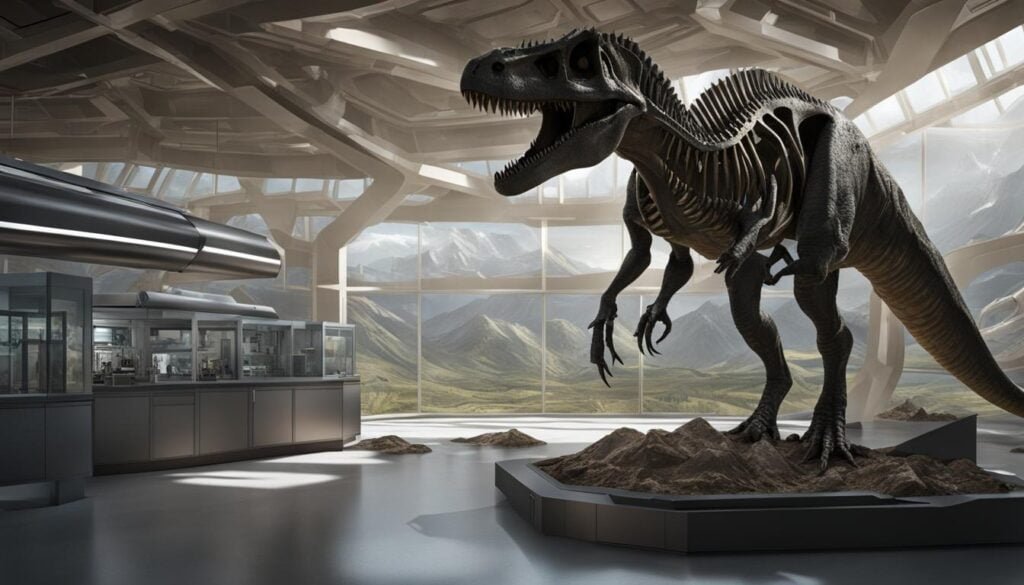
Unraveling the Mysteries of Dinosaur Evolution
Paleontologists are dedicated to unraveling the mysteries of dinosaur evolution, constantly seeking new insights and challenging existing assumptions. Through their meticulous research, they have reshaped the dinosaur family tree and uncovered previously unknown dinosaur groups, providing a more comprehensive understanding of these ancient creatures and their evolutionary history.
“The discovery of new dinosaur species and the reevaluation of existing fossils have led to groundbreaking revelations in our understanding of dinosaur evolution,” says Dr. Emily Grant, a renowned paleontologist. “We are constantly refining our knowledge as we uncover more evidence and apply new analytical techniques.”
One of the key findings in recent years is the realization that some dinosaurs previously thought to be distinct species are actually part of the same group. For example, the Triceratops and Torosaurus were once considered separate species. However, further analysis of their fossil remains and careful examination of their physical characteristics revealed that Torosaurus is actually a mature form of Triceratops.
This discovery highlights the importance of ongoing research and the need to question long-held assumptions in paleontology. By reevaluating fossils and continuously updating our understanding of dinosaur taxonomy, paleontologists are uncovering a more accurate representation of the biodiversity that existed millions of years ago. This work has tremendous implications for our understanding of ancient ecosystems and the processes that shaped life on Earth.
| Dinosaur Group | New Insight |
|---|---|
| Theropods | Many theropod dinosaurs had feathers and were likely ancestors of modern birds. |
| Sauropodomorphs | The discovery of new sauropodomorph species has revealed a wider range of body sizes and adaptations than previously known. |
| Ornithopods | Ornithopods exhibited diverse dental adaptations, suggesting a wide range of feeding strategies. |
| Ankylosaurs | Ankylosaurs had unique armor and defensive adaptations, making them formidable herbivores. |
The ongoing study of dinosaur evolution continues to provide valuable insights into the diversity and complexity of these ancient creatures. Paleontologists are dedicated to pushing the boundaries of our understanding, unearthing new fossil evidence, and utilizing innovative techniques to analyze and interpret the data. With each new discovery, the picture of dinosaur evolution becomes clearer, offering a glimpse into the wonders of prehistoric life.
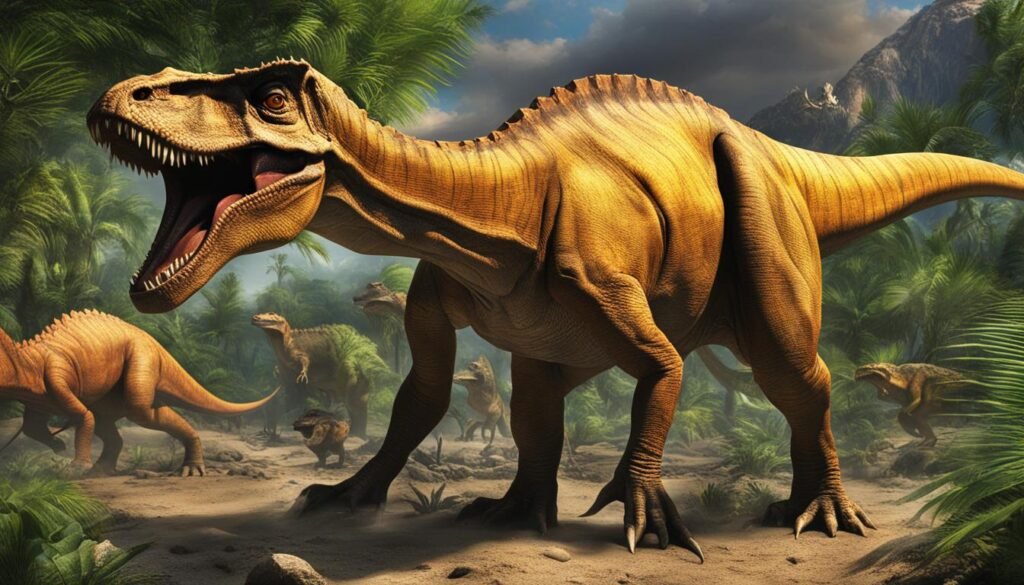
Exploring the Unknown
The exploration of dinosaur evolution is an ongoing journey into the unknown. As paleontologists dig deeper into unexplored territories and recover new fossil specimens, they uncover the secrets of long-extinct ecosystems and shed light on the evolutionary processes that have shaped life on Earth.
- Uncovering the missing links: By identifying transitional species, paleontologists fill gaps in the fossil record and reveal the gradual changes that occurred during major evolutionary transitions.
- Unlocking ancient adaptations: The study of dinosaur evolution provides insights into the unique features and adaptations that allowed these creatures to thrive and dominate their ecosystems.
- Revealing ancient environments: Fossil discoveries offer a window into the diverse landscapes and climates of the past, painting a vivid picture of ancient Earth.
- Informing modern biodiversity conservation: The knowledge gained from studying dinosaur evolution helps us understand the processes that drive biodiversity loss and the importance of preserving modern ecosystems.
The work of paleontologists continues to captivate the imagination and inspire new generations of scientists. As we delve further into the mysteries of dinosaur evolution, we not only unravel the secrets of the past but also gain valuable insights that can shape our future understanding of life on Earth.
The Endless Potential for New Discoveries
Paleontology is a field that continues to amaze with its endless potential for new discoveries. Despite the significant progress made in uncovering the secrets of ancient creatures, experts believe that we have only scratched the surface of what remains to be discovered. Vast unexplored territories around the world hold the promise of revealing millions of undiscovered dinosaur species that once roamed the Earth. The excitement of the ongoing search for these ancient creatures continues to captivate the imagination of scientists and the public alike.
With each passing year, paleontologists are naming new dinosaur species and uncovering previously unknown dinosaur groups. These discoveries reshape our understanding of dinosaurs and contribute to a more comprehensive picture of their evolutionary history. As our exploration of fossil sites expands, the potential for even more fascinating and groundbreaking findings grows.
To showcase the vastness of the unexplored territories for fossil exploration, consider the following table:
| Region | Approximate Area (in square kilometers) | Potential for New Discoveries |
|---|---|---|
| Amazon Rainforest | 7,000,000 | High |
| Sahara Desert | 9,200,000 | High |
| Antarctica | 14,000,000 | High |
| Great Barrier Reef | 348,000 | High |
As depicted in the table, these vast regions offer immense possibilities for new discoveries. The untouched landscapes and fossil-rich areas within these regions are waiting to be explored and reveal their secrets.
The potential for new discoveries in dinosaur paleontology is awe-inspiring. By continuing to invest in the field, supporting research endeavors, and preserving modern biodiversity, we can unlock more of our planet’s ancient past and better understand its future.

The Future of Dinosaur Paleontology
The future prospects of dinosaur fossil excavation hold immense promise for the field of paleontology. Continued support and resources are essential to sustaining the momentum in paleontological research and uncovering new insights into the ancient world.
Supporting paleontological research is of utmost importance. By investing in the exploration of fossil sites and the study of dinosaur fossils, we can gain a greater understanding of the Earth’s history and the evolution of life on our planet. Paleontologists play a vital role in documenting the past and informing our understanding of the present and future.
Preserving modern biodiversity is closely linked to the study of dinosaurs. By studying the fossil record, we can learn valuable lessons about the impact of environmental changes on ancient ecosystems and gain insights into the current challenges facing our planet. The preservation of biodiversity is not only crucial for the conservation of species but also for safeguarding the delicate balance of our ecosystems.
Investing in the future of dinosaur paleontology means investing in the future of our planet. By supporting paleontological research, we can unlock the secrets of our ancient past and better understand the challenges we face in the present and future.
The importance of supporting paleontological research
- Advancing our knowledge of the Earth’s history
- Informing our understanding of current environmental challenges
- Preserving modern biodiversity
- Inspiring future generations of scientists
By providing the necessary resources and funding, we can ensure that the field of dinosaur paleontology continues to thrive and contribute to our understanding of the world we live in. The future of dinosaur paleontology is both exciting and vital, and by supporting this field, we can pave the way for groundbreaking discoveries and a deeper appreciation of our planet’s rich natural history.
| Investing in the Future of Dinosaur Paleontology | Benefits |
|---|---|
| Increased research and discoveries | Uncovering new dinosaur species and expanding our knowledge of ancient ecosystems |
| Enhanced understanding of climate change | Studying past climatic events through fossils helps inform predictions about future environmental changes |
| Conservation and preservation | Highlighting the importance of protecting modern biodiversity and preserving ecosystems |
| Inspiration for future generations | Encouraging scientific curiosity and fostering a love for natural history |
Investing in the future of dinosaur paleontology is an investment in the future of our planet. By supporting paleontological research, we can unlock the secrets of our ancient past and better understand the challenges we face in the present and future. Together, let us preserve the legacy of dinosaurs and ensure a thriving field of paleontology for generations to come.
Conclusion
The future of dinosaur paleontology is filled with excitement and possibilities. The field continues to push boundaries and make groundbreaking discoveries, thanks to advancements in technology and interdisciplinary approaches. As paleontologists delve deeper into the study of dinosaur paleoecology and utilize cutting-edge tools, our understanding of these ancient creatures and their ecosystems expands.
With each new dinosaur discovery, the intricate web of dinosaur evolution is reshaped, challenging existing assumptions and uncovering previously unknown dinosaur groups. The ongoing exploration of the fossil record holds immense potential for new discoveries, with millions of undiscovered dinosaur species waiting to be found. It is a never-ending journey that captivates the imagination and drives scientific curiosity.
However, to ensure the future of dinosaur paleontology, it is crucial to support and invest in the field. Continued funding and resources are needed to sustain research efforts, conduct excavations, and preserve the fossil record. The study of dinosaurs not only contributes to our knowledge of Earth’s history but also provides insights into climate change, biodiversity loss, and the impact of human activity on the environment. By supporting paleontological research, we can unravel more of our planet’s ancient past and gain a better understanding of its future.

